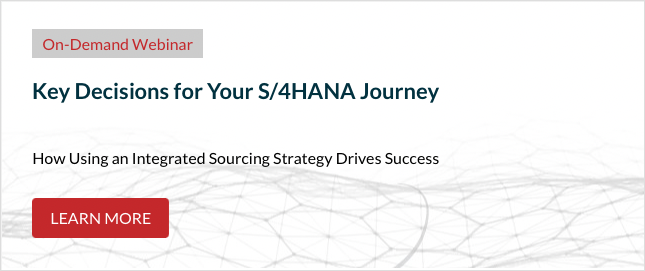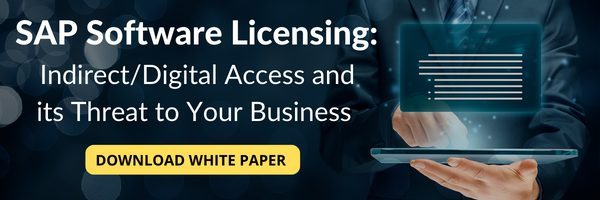- February 13, 2020
- Devin Djerf
- Reading Time: 4 minutes

With the May 2020 expiration date of SAP’s Digital Access Adoption Program (DAAP) fast approaching, SAP customers are feeling pressure to choose whether to remain on Indirect Access or migrate to the Digital Access model in time to take advantage of the DAAP. Here we will provide an overview of each model along with the insights we’ve gained over the years to help you decide which model is most beneficial for your business.
What is Indirect Access?
Indirect Access is a license violation that occurs when SAP software is indirectly accessed via a third-party, non-SAP application or custom interface. For years, Indirect Access was a source of uncertainty and frustration for many customers due to its vague definition and the significant Indirect Access fees they could incur from Indirect Access violations uncovered in an audit. The Indirect Access model is both user- and order-based and pricing can vary in this model. For example, a user accessing the software can vary by type (i.e., Professional, Limited Professional, Employee, Developer), which all have distinct price points. Unless a migration to Digital Access has occurred, this is the default model.
What is Digital Access?
In April 2018, SAP announced Digital Access as an alternative method in an effort to provide more transparency and cost predictability than Indirect Access. The Digital Access model is based on documents created via third-party non-SAP applications indirectly accessing SAP.
Key Pricing Attributes of the Digital Access Model:
- There are 9 document types including:
- Sales
- Purchase
- Invoice
- Manufacturing
- Material
- Quality Management
- Service & Maintenance
- Financial
- Time Management
- Documents are weighted by level of value.
- The volume pricing structure is based on the aggregate number of documents indirectly generated in the environment.
- A credit of up to 100% of the license fees paid for the user and/or order licenses exchanged can be applied toward the new document-based model.
What is DAAP?
In May 2019, SAP announced its Digital Access Adoption Program (DAAP) to facilitate customer migrations from Indirect to Digital Access. Although SAP stated that existing customers currently leveraging Indirect Access may choose to do nothing, they have positioned an attractive two-step process for customers who are considering the migration in which the customer can:
- Work with SAP’s Global License Audit and Compliance (GLAC) team or use SAP’s Passport tool to measure current consumption of documents.
- Choose a financial option for paying for the Digital Access license fee, in which SAP offers two methods:
- The customer licenses at least 115% of estimated document use and only pays for the 15% in growth, or
- The customer licenses 100% of the documents and receives a 90% discount.
Which Model is More Favorable for Customers?
Even though SAP positioned Digital Access as an improved model for customers, our experience has shown the Indirect Access model is generally more favorable. Ultimately, the favorability of SAP’s Digital Access model should be determined on a case-by-case basis and will depend on the unique aspects of your application landscape and the nature of your industry. However, our studies indicate that in 9 out of 10 times, Indirect Access is still the superior method.
The Downsides of Digital Access
In recent negotiations with SAP, we saw SAP inserting some new concepts around S/4HANA Digital Access, more specifically, granting non-humans a license to use particular S/4 software. The non-humans, including bots and devices, are granted the ability to use the S/4 software, even through non-SAP applications.
At first glance, this seems to give the customer leverage and additional access and integration to the SAP software, but there is a caveat: The Digital Access model is document-based, so there is the potential for non-humans to automatically create a larger number of documents than you may have accounted for in your initial assessment, resulting in a high price tag for the customer. In this scenario, the customer could find themselves paying for an increased number of created documents rather than just paying for the non-human user license upfront, either through an initial purchase with SAP or through the Indirect Access model.
In addition, the Passport tool, designed to measure current consumption of documents, has shown issues. For example, SAP does not charge for subsequent generation of documents. In our experience working with customers, SAP’s Passport tool does not have the capability to determine what documents were initially generated and what documents were subsequently generated. This is especially problematic because this can substantially overstate requirements for Digital Access.
Next Steps
If you’re considering a migration to Digital Access, it is critical that you conduct an internal assessment to evaluate the model from a cost and predictability standpoint as well as in the context of your future IT strategy. This will help mitigate current and future risk, especially since current consumption of documents may be understated in the initial stages. Customers should anticipate that SAP will determine a higher number of output documents than their own assessment will.
Customers should continue to do their due diligence and evaluate scenarios in which SAP software interfaces with other applications. As technologies increasingly become interconnected, it is important to review negotiated contracts and to check software use rights in order to understand language that may describe how users can access SAP without the purchase of a license.
It will be interesting to see how SAP positions the Indirect and Digital Access models as the May expiration date draws nearer, but I recommend customers develop a deep understanding of their Indirect and Digital Access compliance situations now. In addition, conducting internal assessments will surely provide the opportunity to get ahead of SAP prior to a potential audit.
Comment below, follow me on Twitter @dcdjerf , find my other UpperEdge blogs and follow UpperEdge on Twitter and LinkedIn. Learn more about our SAP Commercial Advisory Services.


